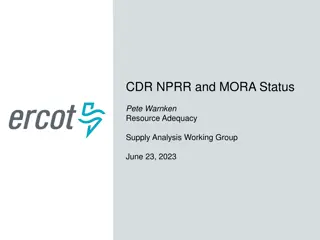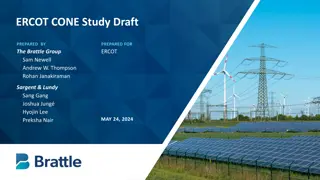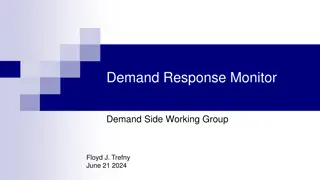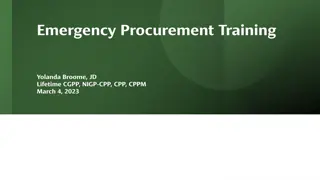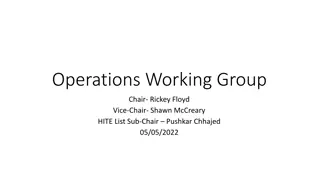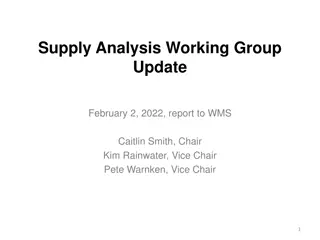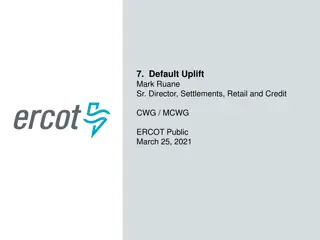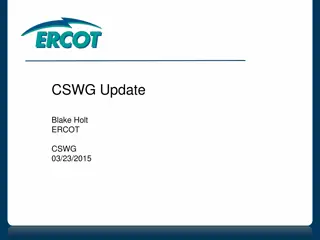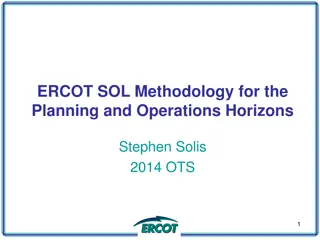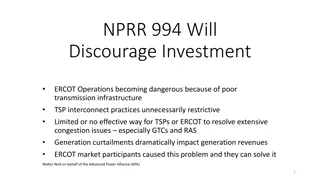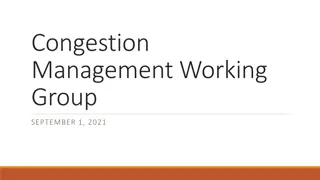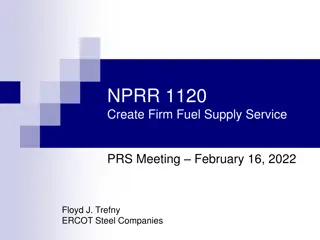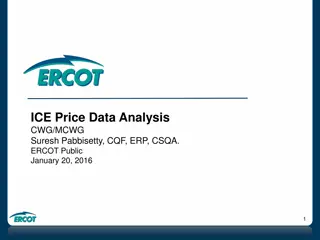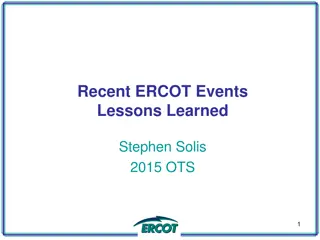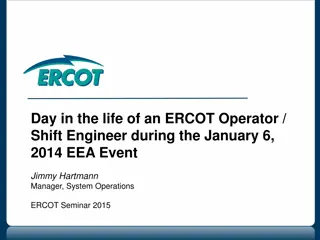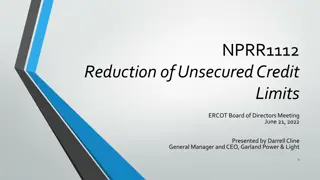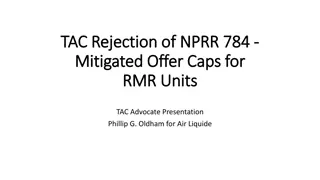Understanding Emergency Conditions in ERCOT Protocols
ERCOT has defined various levels and communication protocols for Emergency Conditions within the electrical grid system. This includes Emergency Notices, Energy Emergency Alerts, operating plans, outage coordination, and requirements related to voltage support for ensuring system safety and reliability. Understanding these protocols is crucial for managing the grid effectively in times of crisis.
Download Presentation

Please find below an Image/Link to download the presentation.
The content on the website is provided AS IS for your information and personal use only. It may not be sold, licensed, or shared on other websites without obtaining consent from the author. Download presentation by click this link. If you encounter any issues during the download, it is possible that the publisher has removed the file from their server.
E N D
Presentation Transcript
Emergency Condition 86 OCCURRENCES IN THE PROTOCOLS. DO THEY ALL HAVE THE SAME OR CONSISTENT MEANING?
Protocol References Section 2 Advisory The second of four levels of communication issued by ERCOT in anticipation of a possible Emergency Condition. Emergency Base Point The target MW output level for a Resource that is selected by ERCOT during an Emergency Condition. Emergency Condition An operating condition in which the safety or reliability of the ERCOT System is compromised or threatened, as determined by ERCOT. Emergency Notice The fourth of four levels of communication issued by ERCOT to declare that ERCOT is operating in an Emergency Condition.
Protocol References Section 2 Energy Emergency Alert (EEA) An orderly, predetermined procedure for maximizing use of available Resources and, only if necessary, curtailing load during an Emergency Condition while providing for the maximum possible continuity of service and maintaining the integrity of the ERCOT System. Operating Condition Notice (OCN) The first of four levels of communication issued by ERCOT in anticipation of a possible Emergency Condition. Watch The third of four levels of communication issued by ERCOT in anticipation of a possible Emergency Condition.
Protocol References Section 3 3.1.4.6 Outage Coordination of Forecasted Emergency Conditions 3.2.6.2.2 Total Capacity Estimate Expected Planned DC Tie Capacity Available under Emergency Conditions 3.9.1 Current Operating Plan (COP) Criteria (J) ONEMR On-Line EMR (available for commitment or dispatch only for ERCOT- declared Emergency Conditions; the QSE may appropriately set LSL and High Sustained Limit (HSL) to reflect operating limits) (D) EMR Available for commitment as a Resource contracted by ERCOT under Section 3.14.1, Reliability Must Run, or under paragraph (2) of Section 6.5.1.1, ERCOT Control Area Authority, or available for commitment only for ERCOT- declared Emergency Condition events 3.10.7.5.1 Continuous Telemetry of the Status of Breakers and Switches (3) Unless there is an Emergency Condition, a TSP or QSE must obtain approval from ERCOT to purposely open a breaker or switch
Protocol References Section 3 3.15.3 Generation Resource Requirements Related to Voltage Support (4) Each Generation Resource providing VSS shall operate with the unit s Automatic Voltage Regulator (AVR) in the automatic voltage control mode unless specifically directed to operate in manual mode by ERCOT, or when the unit is telemetering its Resource Status as STARTUP, SHUTDOWN, or ONTEST, or the QSE determines a need to operate in manual mode in the event of an Emergency Condition at the generating plant.
Protocol References Section 4 4.2.1.1 Ancillary Service Plan (2) If ERCOT determines that an Emergency Condition may exist that would adversely affect ERCOT System reliability, it may change the percentage of Load Resources that are allowed to provide Responsive Reserve (RRS)
Protocol References Section 5 5.7.1.3 Revenue Less Cost Above LSL During RUC-Committed Hours Emergency Energy Amount by interval The payment to the QSE q as additional compensation for the additional energy produced by the Generation Resource r in Real-Time during the Emergency Condition, for the 15-minute Settlement Interval i. 5.7.1.4 Revenue Less Cost During QSE Clawback Intervals Emergency Energy Amount by interval The payment to the QSE as additional compensation for the additional energy produced by the Generation Resource r in Real-Time during the Emergency Condition, for the 15-minute Settlement Interval i.
Protocol References Section 6 6 ADJUSTMENT PERIOD AND REAL-TIME OPERATIONS 6.1 Introduction (4) Under Emergency Conditions, as described in Section 6.5.9, Emergency Operations, ERCOT may implement manual procedures and must keep the Market Participants informed of the status of the system. 6.5.1.1 ERCOT Control Area Authority (e) Perform additional actions required to prevent an imminent Emergency Condition or to restore the ERCOT Transmission Grid to a secure state in the event of an ERCOT Transmission Grid Emergency Condition. (2) Consistent with paragraph (1)(e) above, if ERCOT seeks to exercise its authority to prevent an anticipated Emergency Condition relating to serving Load in the current or next Season by procuring existing capacity that may be used to maintain ERCOT System reliability in a manner not otherwise delineated in these Protocols and the Operating Guides, ERCOT shall take the following actions: Upon determination by ERCOT that additional capacity is needed to prevent an Emergency Conditionand prior to any procurement activity associated with such additional capacity, ERCOT shall issue a Notice as soon as practicable with the following information: (e) ERCOT shall endeavor to minimize the deployment of capacity procured pursuant to this paragraph with the goal of reducing the potential distortion of markets. Resources and Loads deployed to alleviate imminent Emergency Conditions will not be offered into the Day-Ahead Market (DAM). To the extent practicable, the capacity deployed to alleviate imminent Emergency Conditions will not be used solely for the purpose of reducing local congestion.
Protocol References Section 6 6.5.7.3.1 Determination of Real-Time On-Line Reliability Deployment Price Adder (b) RMR Resources that are On-Line, including capacity secured to prevent an Emergency Condition pursuant to paragraph (2) of Section 6.5.1.1, ERCOT Control Area Authority; (f) Real-Time DC Tie exports to address emergency conditions in the receiving electric grid; (h) Energy delivered from ERCOT to another power pool through registered BLTs during emergency conditions in the receiving electric grid. (g) Subtract the MW from Real-Time DC Tie exports to address emergency conditions in the receiving electric grid from GTBD. (i) Subtract the MW from energy delivered from ERCOT to another power pool through registered BLTs during emergency conditions in the receiving electric grid from GTBD.
Protocol References Section 6 6.5.7.6.2.2 Deployment of Responsive Reserve (RRS) (8) Once RRS is deployed, the QSE s obligation to deliver RRS remains in effect until specifically instructed by ERCOT to stop providing RRS. However, except in an Emergency Condition, the QSE s obligation to deliver RRS may not exceed the period for which the service was committed. 6.5.7.6.2.3 Non-Spinning Reserve Service Deployment (1) ERCOT shall deploy Non-Spin Service by operator Dispatch Instruction for the portion of On-Line Generation Resources that is only available through power augmentation and participating as Off-Line Non-Spin, Off-Line Generation Resources and Load Resources. ERCOT shall develop a procedure approved by TAC to deploy Resources providing Non-Spin Service. ERCOT Operators shall implement the deployment procedure when a specified threshold(s) in MW of capability available to SCED to increase generation is reached. ERCOT Operators may implement the deployment procedure to recover deployed RRS or when other Emergency Conditions exist.
Protocol References Section 6 6.5.9 Emergency Operations (2) A QF may only be ordered Off-Line in the case of an ERCOT-declared Emergency Condition with imminent threat to the reliability of the ERCOT System. ERCOT may only Dispatch a QF below its LSL when ERCOT has declared an Emergency Condition and the QF is the only Resource that can provide the necessary relief. (3) ERCOT shall honor all Resource operating parameters in Dispatch Instructions under normal conditions and Emergency Conditions. During Emergency Conditions, ERCOT may verbally request QSEs to operate its Resources outside normal operating parameters. (4) A QSE may not self-arrange for Ancillary Services procured in response to Emergency Conditions. 6.5.9.1 Emergency and Short Supply Operation (1) ERCOT, as the single CAO, is responsible for maintaining reliability in normal and Emergency Conditions.
Protocol References Section 6 6.5.9.3 Communication under Emergency Conditions 4 occurrences 6.5.9.3.1 Operating Condition Notice (1) ERCOT will issue an Operating Condition Notice (OCN) to inform all QSEs of a possible future need for more Resources due to conditions that could affect ERCOT System reliability. OCNs are for informational purposes only, and ERCOT exercises no additional operational authority with the issuance of this type of notice, but may solicit additional information from QSEs in order to determine whether the issuance of an Advisory, Watch, or Emergency Notice is warranted. The OCN is the first of four levels of communication issued by ERCOT in anticipation of a possible Emergency Condition. 6.5.9.3.2 Advisory (1) An Advisory is the second of four levels of communication issued by ERCOT in anticipation of a possible Emergency Condition. 6.5.9.3.3 Watch (1) A Watch is the third of four levels of communication issued by ERCOT in anticipation of a possible Emergency Condition. Plus 1 more
Protocol References Section 6 6.5.9.3.4 Emergency Notice (1) Emergency Notice is the fourth of four levels of communication issued by ERCOT when operating in an Emergency Condition. (3) The actions ERCOT takes during an Emergency Condition depend on the nature and severity of the situation. (4) ERCOT is considered to be in an Emergency Condition whenever ERCOT Transmission Grid status is such that a violation of security criteria, as defined in the Operating Guides, presents the threat of uncontrolled separation or cascading Outages and/or large-scale service disruption to Load (other than Load being served from a radial transmission line) and/or overload of a Transmission Element, and no timely solution is obtainable through SCED or CMPs. (5) If the Emergency Condition is the result of a transmission problem, ERCOT shall act immediately to return the ERCOT System to a reliable condition, including instructing Resources to change output, curtailing any remaining DC Tie Load, and instructing TSPs or DSPs to drop Load. (6) If the Emergency Condition is the result of an Ancillary Service insufficiency, then ERCOT shall follow the EEA procedures.
Protocol References Section 6 6.5.9.4 Energy Emergency Alert (10) During EEA Level 2 or 3, for those constraints that meet the criteria identified in paragraph (5)(a) of Section 6.5.9.3.2, Advisory, ERCOT may control the postcontingency flow to within the 15-Minute Rating in SCED. After PRC is restored to at least 3,000 MW or the emergency condition has ended, whichever is later, and ERCOT has determined that system conditions have improved such that the chance of re-entering into an EEA Level 2 or 3 is low, ERCOT shall restore control to the post-contingency flow to within the Emergency Rating for these constraints that utilized the 15-Minute Rating in SCED. (11) During EEA Level 2 or 3, for those constraints that meet the criteria identified in paragraph (5)(b) of Section 6.5.9.3.2, ERCOT shall continue to enforce constraints associated with double-circuit contingencies throughout an EEA if the double-circuit failures are determined to be at high risk of occurring, due to system conditions. For all other double-circuit contingencies identified in paragraph (5)(b) of Section 6.5.9.3.2, ERCOT will enforce only the associated single-circuit contingencies during EEA Level 2 or 3. ERCOT shall resume enforcing such constraints as a double-circuit contingency after PRC is restored to at least 3,000 MW or the Emergency Condition has ended, whichever is later, and ERCOT has determined
Protocol References Section 6 6.5.9.5 Block Load Transfers between ERCOT and Non-ERCOT Control Areas (d) BLTs of Load from the ERCOT Control Area are: (i) Treated as Resources in the ERCOT Settlement system and may only be instructed with the permission of the affected non-ERCOT Control Area. Under an Emergency Condition, BLTs that have been implemented may be curtailed or terminated by the non-ERCOT Control Area to maintain the reliability of the non-ERCOT system; 6.6.3.4 Real-Time Energy Payment for DC Tie Import (2) ERCOT shall pay each QSE for energy imported into the ERCOT System during a declared Emergency Condition through each DC Tie in response to an ERCOT Dispatch Instruction. Real-Time Emergency DC Import per QSE per Settlement Point The aggregated DC Tie Schedule for emergency energy imported by QSE q into the ERCOT System during Emergency Conditions through DC Tie p, for the 15- minute Settlement Interval. Verified Emergency Energy Price at DC Tie Point The ERCOT verified cost for the energy imported by QSE q into the ERCOT System during declared Emergency Condition through a DC Tie p as instructed by a Dispatch Instruction.
Protocol References Section 6 6.6.3.5 Real-Time Payment for a Block Load Transfer Point (1) ERCOT shall pay each QSE for the energy delivered to an ERCOT Load through a Block Load Transfer (BLT) Point that is moved in response to an ERCOT Verbal Dispatch Instruction (VDI) during a declared Emergency Condition, from the ERCOT Control Area to a non-ERCOT Control Area. The payment for a given 15-minute Settlement Interval is calculated as follows: Verified Emergency Energy Price at BLT Point - The ERCOT verified cost for the energy delivered to an ERCOT Load through BLT Point bltp during a declared Emergency Condition in ERCOT as determined by an ERCOT VDI. (3) For the purpose of Settlement, ERCOT shall treat the energy associated with the Presidio Exception like energy delivered to an ERCOT Load through a BLT Point that is moved from the ERCOT Control Area to a non-ERCOT Control Area in response to a VDI during a declared Emergency Condition, by allowing for compensation of verified costs associated with the energy.
Protocol References Section 6 6.6.6.3 RMR Adjustment Charge Emergency Energy Amount per QSE per Settlement Point per unit per interval The payment to QSE q for the additional energy produced by RMR Unit r at Resource Node p in Real-Time during the Emergency Condition, for the 15-minute Settlement Interval i. 6.6.9 Emergency Operations Settlement (1) Due to Emergency Conditions or Watches, additional compensation for each Generation Resource for which ERCOT provides an Emergency Base Point may be awarded to the QSE representing the Generation Resource. If the Emergency Base Point is higher than the SCED Base Point immediately before the Emergency Condition or Watch and the Settlement Point Price at the Resource Node is lower than the Generation Resource s Energy Offer Curve
Protocol References Section 6 6.6.9.1 Payment for Emergency Power Increase Directed by ERCOT (1) If the Emergency Base Point issued to a Generation Resource is higher than the SCED Base Point immediately before the Emergency Condition or Watch, then ERCOT shall pay the QSE an additional compensation for the Resource at its Resource Node Settlement Point. 6 variable definitions 6.6.12.1 Switchable Generation Make-Whole Payment Variable Unit Definition EMREAMT q, r, p, i $ Emergency Energy Amount per QSE per Settlement Point per unit per interval The payment to QSE q for the additional energy produced by Generation Resource r at Resource Node p in Real-Time during the Emergency Condition, for the 15-minute Settlement Interval i. Payment for emergency energy is made to the Combined Cycle Train.



